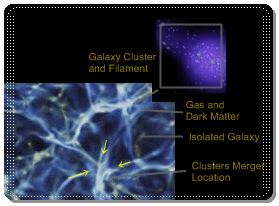
| CONTENT - How the web Universe is impacting how galaxies group into clusters and superclusters |
Lattice-like structures now known like 'filaments' are giving the Universe its form of a cosmic web, which is a point unto which most of astronomers now agree. Galaxy filaments that make up the large-scale structure of the Universe are drawn together by the influence of gravity into sinuous threads weaving through space. Between these filaments stretch shallow but immense voids, where, outside of the extremely rare presence of a galaxy, there is very little matter —about one atom per cubic meter. Spanning vast distances between galaxy clusters, those filaments and clusters of galaxies evolved from the inflation episode during which, some 13.7 billion years ago, the Universe endured a colossal and rapid expansion. Which made the irregularities which had been born from the initial Big Bang explosion of energy grow also into areas of gravitational clumping or denser patches of material. The clumps and threads of this primordial matter eventually cooled, and some of it has condensed into the galaxies and galaxies clusters we see today with the knots of the filaments places where gravity attracted such structures. Leftover gas strewn into filaments between galaxy clusters and much of it is still quite hot -about 1.8 million degrees Fahrenheit (one million degrees Celsius)- and blazing in high-energy X-rays that permeate galaxy clusters. Filaments are therefore best detected in X-ray light, as astronomers are managing to measure the density of them. Radio lobes of isolated galaxies with polar jets, found inside a filaments are also a way for as such lobes arced by the pressure of the filament's particles are good markers of those, or their density

Along the web universe, with gas, gravity and dark matter like mediators, galaxies tend to form, to bunch together into galaxy clusters. These galaxy groupings themselves often keep company with other clusters in "superclusters" that loom as gargantuan, gravitationally associated walls of galaxies. 'Galaxy groups' are like their larger cousins, galaxy clusters, but instead of containing hundreds or even thousands of galaxies like clusters do, galaxy groups are typically comprised of 50 or fewer galaxies. Like galaxy clusters, groups of galaxies are enveloped by giant amounts of hot gas that emit X-rays. Such celestial neighbourhoods may be arranged function of the supermassive black hole activity of the galaxy at the center of the group
Galaxy clusters are the most massive cosmic structures held together by gravity and, like the galaxies they contain, they are featuring large amounts of hot gas and even larger amounts of invisible dark matter. On a larger scale, galaxies and galaxy clusters appear to be thus linked in a gigantic filamentary network, with the most massive clusters sitting in the densest hubs of that cosmic web. The web, which consists primarily of dark matter and some ordinary matter, behaves as the scaffolding of the Universe. Diffuse gas is also arranged in a similar way. Gas and galaxies in the filaments amount to about one tenth of the total mass and the rest being dark matter
Website Manager: G. Guichard, site 'Amateur Astronomy,' http://stars5.6te.net. Page Editor: G. Guichard. last edited: 12/7/2015. contact us at ggwebsites@outlook.com